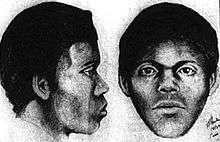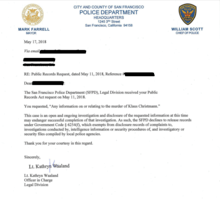Doodler
| The Doodler | |
|---|---|
 Police sketch of the suspect | |
| Born | Unknown |
| Other names | The Black Doodler |
| Details | |
| Victims | 14 dead 3 survived |
Span of crimes | January 1974–September 1975 |
| Country | United States |
| State(s) | California |
Date apprehended | Not apprehended |
The Doodler, also known as the Black Doodler, is an unidentified serial killer believed responsible for 14 murders and three assaults of men in the gay community of San Francisco, California, between January 1974 and September 1975.[1] The nickname was given due to the perpetrator's habit of sketching his victims prior to their sexual encounters and slayings by stabbing.[2] The perpetrator met his victims at gay nightclubs, bars and restaurants.[3][1]
Murders
It is believed that the Doodler killed up to 14 people.[4] A consistent method used in several of the killings was stabbing the victims in the front and back of their bodies.[5] Police theorized that the victims had all died after meeting with the suspect near the locations where their bodies were recovered.[6] Police initially believed there could have been as many as three different perpetrators during early stages of the investigation.[1]
Gerald Cavanaugh
Gerald Earl Cavanaugh, a Canadian-American immigrant, is believed to be the Doodler's first victim.[3] He was 49 at the time of his slaying, which had occurred by stabbing. Cavanaugh's fully clothed body was located on January 24, 1974, lying face-up on Ocean Beach in San Francisco, California, in the early hours of the morning.[7] He had died hours before.[8] He was determined to have been conscious at the time he was killed and had attempted to resist his killer because he had self-defense wounds.[6] He initially remained unidentified, being temporarily known as "John Doe #7" by the medical examiner. He was a single man with few details about his personal life.[9]
Joseph "Jae" Stevens
Joseph Stevens, best known by the nickname "Jae" was discovered by a woman walking along Spreckels Lake, located in San Francisco on June 25, 1974.[10] Stevens was 27 and had died shortly before his body was found; he had been witnessed at a club the previous day. He was employed as a "female impersonator" and comedian. Officers suspected that Stevens was alive at the time he had been at Spreckels Lake, possibly transporting himself to the area with his killer.[6]
Klaus Christmann
Klaus Christmann, a German-American immigrant, was discovered by a woman walking her dog on July 7, 1974.[11] His death had been somewhat more violent than the previous murders because he had considerably more stab wounds than Stevens and had been slashed in the throat several times.[7] The body was fully clothed.[6] Christmann, unlike the previous victims, was married and had children. The fact that he had a "make-up tube" on his person when he died suggested to police he may have been a closeted gay man.[6]
He remained unidentified briefly while police were investigating the cases, which they had believed were related after the third murder. He was buried in his native country.[6]
Frederick Capin
Frederick Elmer Capin, aged 32, was discovered on May 12, 1975 in San Francisco.[12] He had been stabbed, like the other victims, dying from strikes to his aorta. It is believed his body had been moved approximately 20 feet as disturbances in the nearby sand indicated. Capin was identified through fingerprints when these were matched to those taken "by the state" due to his occupation as a nurse.[13] He also had served in the United States Navy, earning medals while serving in the Vietnam War.[6]
Harald Gullberg
Harald Gullberg, aged 66, was a Swedish-American immigrant who was discovered on June 4, 1975 in a decomposed state about two weeks after his death in Lincoln Park.[9] He remains slightly inconsistent with the other homicides because he was far older than the others, his underwear had been taken by his killer and his pants were unzipped. Gullberg is believed to be the final victim of the Doodler.[3] While he remained unidentified, he was known as "John Doe #81."[6]
Investigation

Police questioned a young man as a murder suspect in the case but could not proceed with criminal charges because the three surviving victims did not want to "out" themselves by testifying against him in court.[14][1] Among the stabbing survivors were a "well-known entertainer" and a diplomat.[15][16] The suspect cooperated with police during his interview but he never admitted guilt for the murders and attacks.[1] Officers stated that they strongly believed that the man in question was responsible for the crimes, but he was never tried or convicted because of the survivors' refusals to appear in court.[16][9] To date, the suspect never has been named publicly or apprehended; very little information is available about the crimes.[1][17]
Two other potential suspects arose in 1977 after a pair of men from Redondo Beach and Riverside, California were questioned after their arrests under suspicion of murders with similar circumstances, approximately 28 that occurred after "homosexual encounters."[16]
Status
As of May 2018, the case is open and ongoing in the San Francisco Police Department.[18] With new DNA technology since the crimes, the police department has been trying to see where the case is at and if anything is worth sending to a DNA lab.[19][20]
Aftermath
At the time, activist Harvey Milk publicly expressed empathy for the victims who refused to speak with police, stating "I understand their position. I respect the pressure society has put on them." Milk elaborated that the three men likely feared damaging relationships with family and in the workforce, citing that he believed only "20% to 25%" of the 85,000 gay men in San Francisco were open about their sexualities.[16]
References
- 1 2 3 4 5 6 Newton, Michael (2009). The Encyclopedia of Unsolved Crimes. New York: Facts on File. p. 111. ISBN 9781438119144. Retrieved June 1, 2013.
- ↑ Mojadad, Ida (2018-06-21). "'Doodler' Back in Limelight Despite No Updates to Case". SF Weekly. Retrieved 2018-06-25.
- 1 2 3 Robinson, Eugene (November 13, 1975). "One-Killer Theory In 6 S.F. Murders". San Francisco Chronicle. Archived from the original on September 20, 2018. Retrieved September 20, 2018.
- ↑ Mojadad, Ida (2018-04-26). "Meet the Californian Serial Killers Who Haven't Been Caught...Yet - April 26, 2018 - SF Weekly". SF Weekly. Retrieved 2018-06-13.
- ↑ "The Sado Murder Horror". The San Francisco Chronicle. January 19, 1976.
- 1 2 3 4 5 6 7 8 Green, Elon (11 December 2014). "The Untold Story of the Doodler Murders". The Awl. Archived from the original on January 11, 2018. Retrieved 25 January 2016.
- 1 2 Watt, Nick (June 21, 2018). "After more than 40 years, police say they have a suspect in cold case". CNN. Retrieved 2018-06-25.
- ↑ "2 Stabbing Deaths--One Suspect Arrested".
- 1 2 3 Calhoun, Bob (8 October 2015). "Yesterday's Crimes: The Serial Killer Who Stalked Gay Men in the Castro". SF Weekly. Foundation. Archived from the original on January 11, 2018. Retrieved 25 January 2016.
- ↑ "Entertainer stabbed to death in GG Park". The San Francisco Examiner. June 25, 1974. Archived from the original on September 20, 2018. Retrieved September 20, 2018.
- ↑ "Police are asking for Help...". The San Francisco Sentinel. July 18, 1974.
Police are asking for help in the identification of this 25 year old man that was found on Ocean Beach on July 7.
- ↑ "Body of stab victim found at Ocean Beach". The San Francisco Examiner. May 12, 1975. Archived from the original on September 20, 2018. Retrieved September 20, 2018.
- ↑ "Murder Unsolved". The San Francisco Sentinel. May 22, 1975.
- ↑ of TIME-LIFE, Editors (2017). TIME-LIFE The Most Notorious Serial Killers. Time Inc., Books. ISBN 1683300289.
- ↑ "The Mystery Witness in S.F. Gay Murders". San Francisco Chronicle. July 9, 1977. Archived from the original on September 20, 2018. Retrieved September 20, 2018.
- 1 2 3 4 Staff (July 8, 1977). "Murder suspect free because gays silent". Associated Press. p. 13C. Retrieved 1 June 2013.
- ↑ Vronsky, Peter (2004). Serial Killers: The Method and Madness of Monsters. New York: Penguin. p. 16. ISBN 9780425196403. Retrieved 1 June 2013.
- ↑ "'Doodler killer' cold case has renewed interest". ABC13 Houston. 2018-06-25. Retrieved 2018-06-25.
- ↑ Dowd, Katie (June 21, 2018). "Who was San Francisco's Doodler killer, and why wasn't he caught?". SFGate. Retrieved 2018-06-25.
- ↑ Fagan, Kevin; Sernoffsky, Evan (May 5, 2018). "DNA research in Golden State Killer case spurs hope in unsolved killings". San Francisco Chronicle. Retrieved 2018-06-13.
We’re still putting together all the various pieces in the Doodler case to see where it’s at.
External links
- The Untold Story of the Doodler Murders, The Awl, published on December 11, 2014.